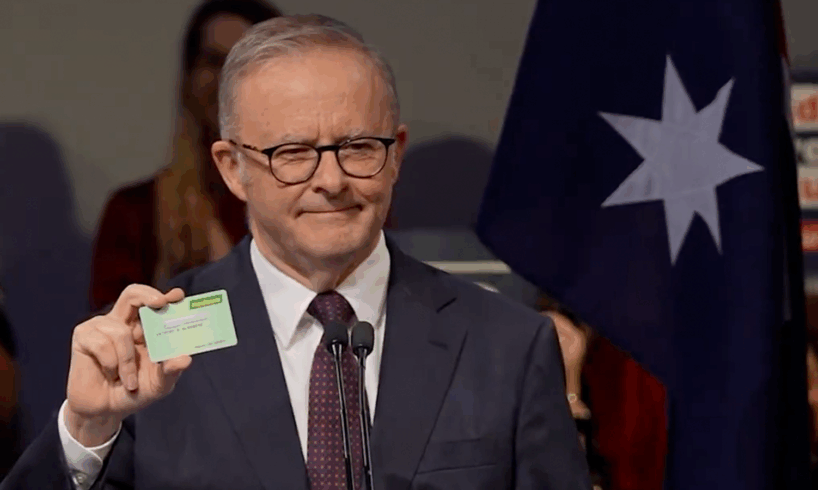
Recent health statistics, plus a departmental briefing to the Albanese government, have confirmed the fraud of Labor’s May 3 election pledge that by 2030, 90 percent of people could see a doctor under the Medicare bulk-billing scheme without paying an increasingly expensive upfront fee.
As the WSWS warned in the lead-up to the election: “Similar pledges, to ‘save Medicare,’ have been made in every election for decades, only to be broken by Labor and Coalition governments alike once the polls closed.”
Australian Prime Minister Anthony Albanese holds up Medicare card during 2025 election campaign. [Photo: Australian Labor Party]
Throughout the election campaign, Prime Minister Anthony Albanese repeatedly flashed a Medicare card and declared “all you should need to see a doctor for free in Australia is your Medicare card … not your credit card.” Equally cynically, the then Liberal-National Coalition leader Peter Dutton matched this pledge.
Labor claimed that $8.5 billion in supposed extra funding—to be delivered over four years—would lift bulk-billing rates to 90 percent. That was to be achieved largely through an increase in the basic Medicare payment to doctors from $42.85 to an expected $70 for every appointment lasting 20 minutes or less. This incentive would apply only to clinics that bulk-billed for all their services.
In its post-election brief, however, the Department of Health, Aged Care and Disability told Health Minister Mark Butler that nearly a quarter of doctors’ clinics, which operate as profit-making businesses, were unlikely to take up the offer, deeming the incentive payments to be inadequate.
According to a report in the Australian newspaper, the department also said the portion of general practitioner (GP) clinics bulk-billing all services had halved in the past three years, falling to 26 percent.
That may be an understatement of the steep decline since the Albanese government first took office in May 2020.
As reported in February, between October 2024 and January 2025, the healthcare directory website Cleanbill called 6,925 GP clinics across Australia and found that only 20.7 percent bulk-billed for all standard consultations.
Last month, a follow-up Cleanbill report estimated that the average upfront payment, or “out-of-pocket” cost to patients, was $43. That is a punishing bill for a working-class household amid a continuing cost-of-living crisis.
According to other official figures, the overall percentage of patients being bulk-billed, rather than charged upfront, has fallen sharply under the Labor government since 2022 from 88.5 percent to 77.5 percent, despite Labor’s claims to be reversing the damage done under the previous Coalition government. That is far below Labor’s 90 percent pledge.
Mehring Books
The Wuhan Lab Lie and the Fight for Scientific Truth
This pamphlet provides an overview of the principled stand taken by the WSWS against the far-right Wuhan Lab Lie. It is essential reading for all those seeking to defend science and public health.
Nor have Labor’s new subsidised Medicare Urgent Care Clinics (UCCs), also run by private operators, substantially improved the situation or alleviated the burden on under-funded and under-staffed public hospitals. An interim report in January found that 12 percent of UCC patients waited longer than 60 minutes to be seen, despite seeking urgent care for injuries or illnesses for which they previously would have sought treatment at a hospital emergency department.
This is part of an overall public health crisis that particularly affects workers, pensioners, welfare recipients and others on low incomes, exacerbating the growth of social inequality.
A report from the Grattan Institute think tank last month found that out-of-pocket costs for non-GP specialists have outstripped Medicare reimbursements to patients by 73 percent in real terms since 2010.
The report estimated that more than one in five patients who saw a non-GP specialist in 2023 was charged an “extreme fee”—defined as more than three times the Medicare reimbursement.
Overall, out-of-pocket costs for specialist appointments rose by 158 percent from 2010 to 2025, more than three times the 49 percent growth in the official Wage Price Index. An initial consultation with a cardiologist or endocrinologist could cost up to $370, and up to $670 for a psychiatrist.
As a result, every year about 1.9 million people delayed or avoided getting the care they needed, causing missed diagnoses, avoidable suffering and added pressure on public hospitals.
Largely this was driven by profit-making. From 2006 to 2021, the cost of running clinics rose 2 percent a year, while profits rose by about 5 percent a year.
The report estimated that free clinics run by public hospitals provided only a third of all specialist care and criticised their wait times as “often far too long.” It stated: “In many parts of Australia, wait times for urgent appointments are months longer than clinical guidelines recommend.”
The Grattan report described non-GP specialist care as “a postcode lottery.” People in wealthy areas received about a quarter more services than those in poorer ones, despite wealthier people generally being healthier. On average, poorer Australian residents die about 7.5 years earlier than the wealthiest and spend more years living with chronic disease.
A wider austerity warning
In its post-election brief, the Department of Health, Aged Care and Disability said projections of health spending overall fell short of the level required to maintain current funding as a percentage of gross domestic product (GDP).
“In 2022–23, health spending accounted for 9.9 percent of GDP, approximately 0.5 percent lower than in 2021–22,” the brief stated.
The department referred to pressure from the Labor government to cut further. “The government’s desire is to not significantly increase the proportion provided to health,” it said.
Later, the brief revealed: “The department will experience a 6 to 10 percent decrease in internal resourcing from July 1, 2025, with further decreases expected in 2026–27.”
Worse lies ahead. The department noted the more “fiscally constrained environment” Labor needed to impose in its second term in office: “We are acutely aware of the importance of returning Australia’s budget to a stronger, more sustainable fiscal position.”
The brief declared the need for “tough decisions” across the entire range of health, disability and aged care services:
“Health, disability and aged care system financing is a significant proportion of Australian government expenditure. This will also be a time requiring some tough decisions on spending, with continually increasing demands on the health dollar, and with international forces driving considerable economic turbulence.”
This is another warning of Labor’s wider assault on social services, which will deepen further as the Trump administration’s trade war intensifies and Labor escalates military spending to prepare for a US-led war on China—having already allocated hundreds of billions of dollars for AUKUS submarines and other weaponry.
Labor’s false promises on healthcare underscore the necessity for a socialist alternative.
Medicare, like its predecessor Medibank, introduced in 1975, was supposed to enable working people to see a GP without charge, via bulk-billing, and to obtain free treatment at a public hospital. Both these promises have been increasingly killed off by governments at federal and state levels.
Moreover, Medicare has never provided free, universal health care. Many essential services, such as dental care, are not covered. Long waiting times for treatment in public hospitals have forced 15 million people—more than half the population—into buying expensive private health insurance.
This has produced a two-class health system, with profit-making private clinics and hospitals prospering alongside chronically over-stretched public hospitals.
As part of its program, the Socialist Equality Party calls for the complete socialist reorganisation of society to secure the social rights of all, including free, high-quality, readily-accessible healthcare. Instead of the ever-greater subordination of healthcare to the capitalist profit system, billions of dollars must be dedicated to upgrading, expanding and staffing public hospitals, medical clinics and the full range of modern health services.
Join the fight to end the COVID-19 pandemic
Someone from the Socialist Equality Party or the WSWS in your region will contact you promptly.





